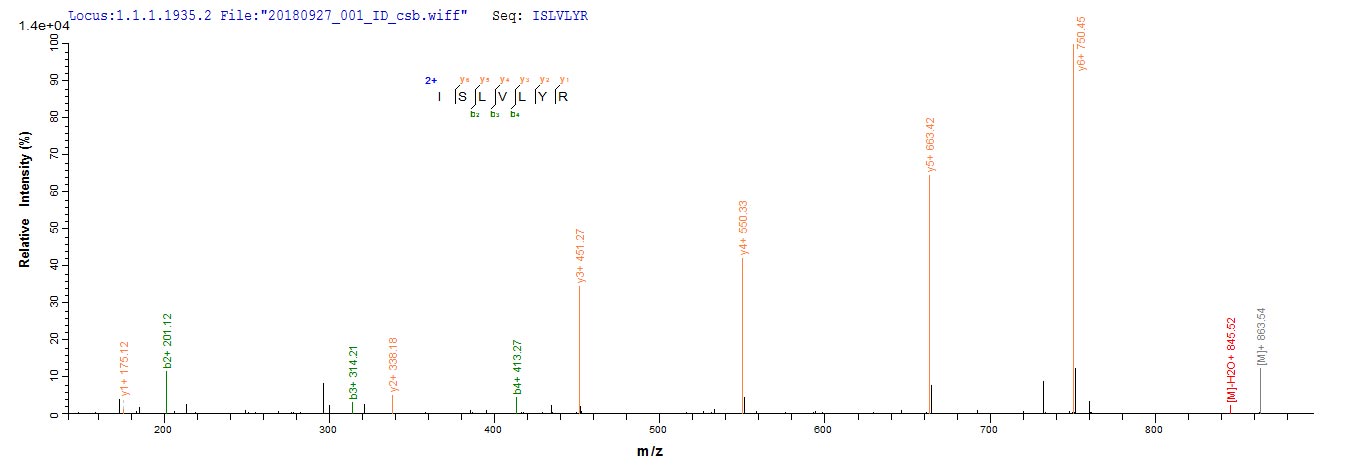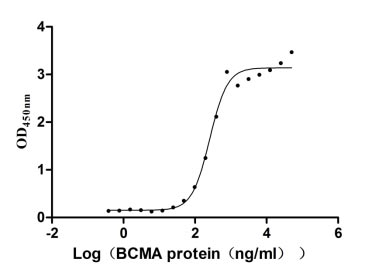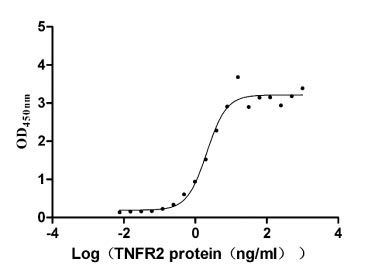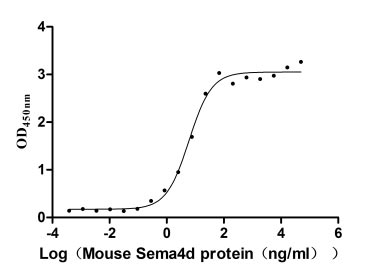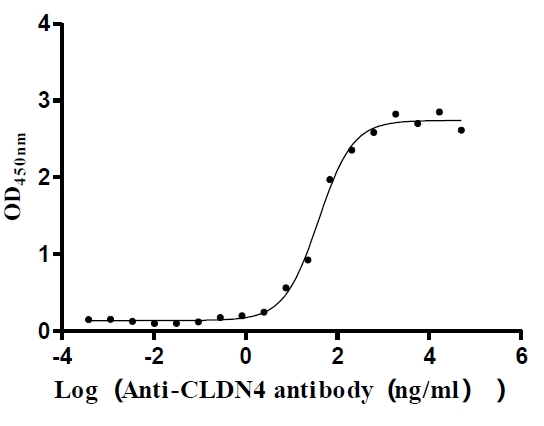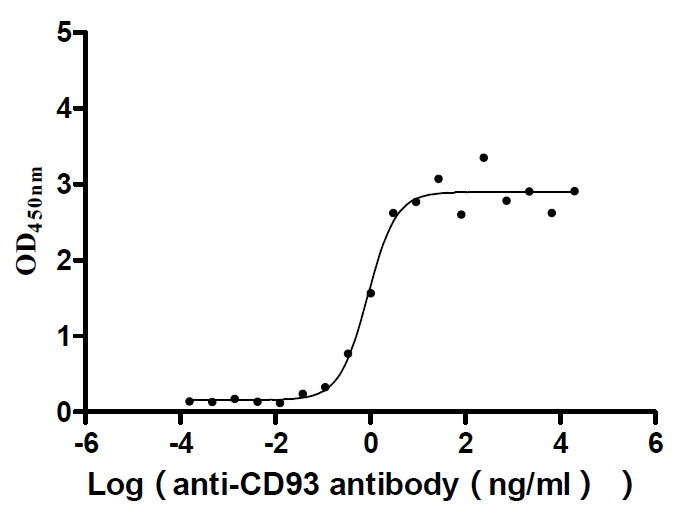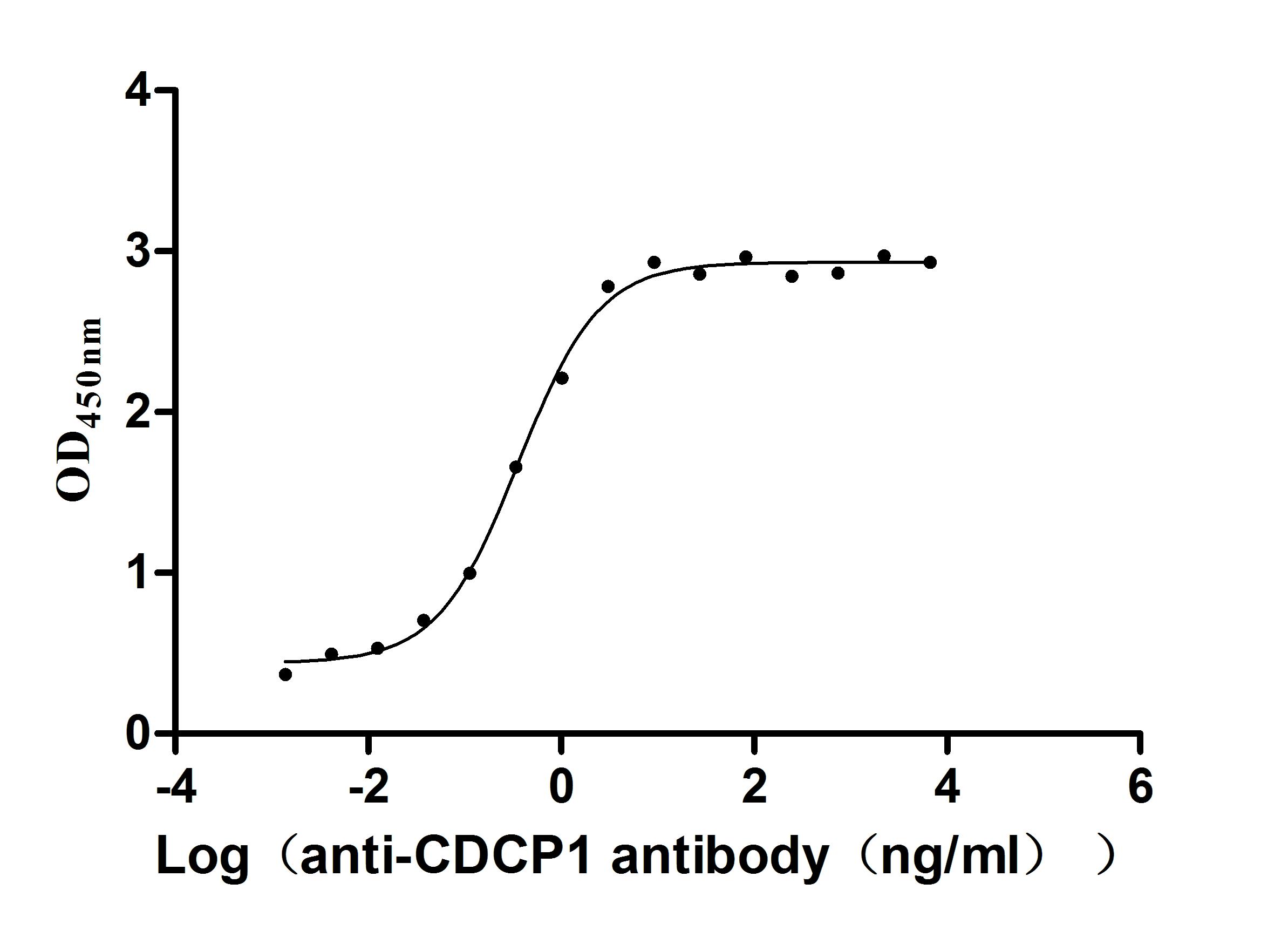Recombinant Mouse Methylcytosine dioxygenase TET2 (Tet2), partial
-
中文名称:小鼠Tet2重组蛋白
-
货号:CSB-EP678395MO
-
规格:¥2328
-
图片:
-
Based on the SEQUEST from database of E.coli host and target protein, the LC-MS/MS Analysis result of CSB-EP678395MO could indicate that this peptide derived from E.coli-expressed Mus musculus (Mouse) Tet2.
-
Based on the SEQUEST from database of E.coli host and target protein, the LC-MS/MS Analysis result of CSB-EP678395MO could indicate that this peptide derived from E.coli-expressed Mus musculus (Mouse) Tet2.
-
-
其他:
产品详情
-
纯度:Greater than 85% as determined by SDS-PAGE.
-
基因名:
-
Uniprot No.:
-
别名:Tet2; Kiaa1546Methylcytosine dioxygenase TET2; EC 1.14.11.n2; Protein Ayu17-449
-
种属:Mus musculus (Mouse)
-
蛋白长度:Partial
-
来源:E.coli
-
分子量:27.0 kDa
-
表达区域:1810-1912aa
-
氨基酸序列RISLVLYRHKNLFLPKHCLALWEAKMAEKARKEEECGKNGSDHVSQKNHGKQEKREPTGPQEPSYLRFIQSLAENTGSVTTDSTVTTSPYAFTQVTGPYNTFV
Note: The complete sequence including tag sequence, target protein sequence and linker sequence could be provided upon request. -
蛋白标签:N-terminal 6xHis-KSI-tagged
-
产品提供形式:Liquid or Lyophilized powder
Note: We will preferentially ship the format that we have in stock, however, if you have any special requirement for the format, please remark your requirement when placing the order, we will prepare according to your demand. -
缓冲液:Tris-based buffer,50% glycerol
-
储存条件:Store at -20°C/-80°C upon receipt, aliquoting is necessary for mutiple use. Avoid repeated freeze-thaw cycles.
-
保质期:The shelf life is related to many factors, storage state, buffer ingredients, storage temperature and the stability of the protein itself.
Generally, the shelf life of liquid form is 6 months at -20°C/-80°C. The shelf life of lyophilized form is 12 months at -20°C/-80°C. -
货期:Basically, we can dispatch the products out in 1-3 working days after receiving your orders. Delivery time may differ from different purchasing way or location, please kindly consult your local distributors for specific delivery time.Note: All of our proteins are default shipped with normal blue ice packs, if you request to ship with dry ice, please communicate with us in advance and extra fees will be charged.
-
注意事项:Repeated freezing and thawing is not recommended. Store working aliquots at 4°C for up to one week.
-
Datasheet & COA:Please contact us to get it.
相关产品
靶点详情
-
功能:Dioxygenase that catalyzes the conversion of the modified genomic base 5-methylcytosine (5mC) into 5-hydroxymethylcytosine (5hmC) and plays a key role in active DNA demethylation. Has a preference for 5-hydroxymethylcytosine in CpG motifs. Also mediates subsequent conversion of 5hmC into 5-formylcytosine (5fC), and conversion of 5fC to 5-carboxylcytosine (5caC). Conversion of 5mC into 5hmC, 5fC and 5caC probably constitutes the first step in cytosine demethylation. Methylation at the C5 position of cytosine bases is an epigenetic modification of the mammalian genome which plays an important role in transcriptional regulation. In addition to its role in DNA demethylation, also involved in the recruitment of the O-GlcNAc transferase OGT to CpG-rich transcription start sites of active genes, thereby promoting histone H2B GlcNAcylation by OGT.
-
基因功能参考文献:
- These results highlight the critical role of TET2 in the maintenance of BMSC functions and osteoblast differentiation and provide evidence that dysregulation of epigenetic modifiers in BMSCs contributes to the progression of myeloid malignancies. PMID: 29290626
- Tet2/Nras double-mutant leukemia showed preferential sensitivity to MAPK kinase (MEK) inhibition in both mouse model and patient samples PMID: 29275866
- Results indicate that tet oncogene 1 protein (Tet1) and tet oncogene 2 protein (Tet2) play a critical role in maintaining bone marrow MSCs (BMMSCs) and bone homeostasis through demethylation of P2X7 purinoceptor (P2rX7) to control exosome and miRNA release. PMID: 29858571
- RHOA G17V expression together with Tet2 loss resulted in development of angioimmunoblastic T cell lymphoma in mice PMID: 29398449
- findings demonstrate the requirement for microbial-dependent inflammation in the development of pre-leukaemic myeloproliferation (PMP) and provide a mechanistic basis for the variation in PMP penetrance observed in Tet2(-/-) mice; this study will prompt new lines of investigation that may profoundly affect the prevention and management of haematopoietic malignancies PMID: 29769727
- Tet2-/- mice develop spontaneous myeloid, T- and B-cell malignancies after long latencies with higher mutation frequencies at genomic sites that gained 5-hydroxymethylcytosine, where Tet2 normally binds. PMID: 28440315
- these results indicate that Tet2 is involved in myoblast differentiation through promoting DNA demethylation and myogenic gene expression. PMID: 28272491
- this is the first evidence to suggest that TET2 mutations promote clonal dominance with aging by conferring TNFalpha resistance to sensitive bone marrow progenitors while also propagating such an inflammatory environment. PMID: 29195897
- Suggest a role for TET2 in the pathogenesis of psoriasiform dermatitis. PMID: 29542811
- TET2 plays an important role in the pathogenesis of diabetic nephropathy by activating TGFbeta1 expression through demethylation of CpG islands in the TGFbeta1 regulatory region PMID: 29705354
- study reveals a previously unknown regulatory role of Tet2 at the epitranscriptomic level, promoting myelopoiesis during infection in the mammalian system by decreasing 5-mCs in mRNAs; moreover, the inhibitory function of cytosine methylation on double-stranded RNA formation and Adar1 binding in mRNA reveals its new physiological role in the mammalian system PMID: 29364877
- This work revealed a critical role of TET2-mediated DNA demethylation against oxidative stress, and provided the molecular mechanisms underlying the epigenetic regulation of iron homeostasis in response to stress erythropoiesis. PMID: 28697999
- Iron(II)/alpha-Ketoglutarate-Dependent Catalytic Domains of the TET Enzymes PMID: 27362828
- TET2 has the effect of inhibiting LPS-induced macrophage activation and plays an inhibitory role in macrophage M1 and M2 polarization. PMID: 29089070
- TET1 and TET2 play an important role in the proliferation of neural stem cells in the adult mouse brain. PMID: 27778125
- we identified that TET2 was downregulated during the pathogenesis of atherosclerosis. The downregulation of TET2 promotes the methylation of the Beclin 1 promoter, leading to endothelial cell autophagy, impaired autophagic flux, and inflammatory factor upregulation. PMID: 27821816
- These findings suggest that the catalytic and scaffolding activities of TDG are essential for retinoic acid-dependent gene expression and provide important insights into the mechanisms underlying targeting of TET-TDG complexes. PMID: 28538185
- TET2 requires its catalytic activity in hematopoietic stem/progenitor cells to exert its myeloid malignancy-suppressive function PMID: 27003514
- this article demonstrates that TET2 regulates CD8+ T cell differentiation PMID: 29150566
- TET proteins, particularly TET2, were required for adipogenesis by modulating DNA methylation at the Ppargamma locus, subsequently by inducing Ppargamma gene expression. PMID: 28100914
- Tet methylcytosine dioxygenase 2 (TET2) was the most highly expressed Tet enzyme in murine macrophage (MPhi) differentiation. PMID: 28826859
- in the absence of TET2, mast cell differentiation is under the control of compensatory mechanisms mediated by other TET family members, while proliferation is strictly dependent on TET2 expression. PMID: 27160912
- ablation of Tet2 in myeloid cells suppresses melanoma growth in vivo and shifted the immunosuppressive gene expression program in tumor-associated macrophages to a proinflammatory one PMID: 28813659
- These results support the hypothesis that somatic TET2 mutations in blood cells play a causal role in atherosclerosis. PMID: 28104796
- Loss of TET2 expression is associated with development of malignancy. PMID: 27428748
- confirm the transformation potential of DNMT3A(R882H) Tet2(-/-) progenitors and represent the first cooperative model in mice involving Tet2 inactivation driving lymphoid malignancies PMID: 26876596
- indicate that AID and TET2 share common effects on myeloid and erythroid lineage differentiation, however, their role is nonredundant in regulating HSC self-renewal and in myeloid transformation. PMID: 28077417
- the results showed that low shear stress downregulated endothelial cell autophagy by impaired TET2 expression, which might contribute to the atherogenic process. PMID: 26493943
- Zfp281 interacts with Tet1, but not Tet2, and its direct transcriptional target, miR-302/367, to negatively regulate Tet2 expression to establish and maintain primed pluripotency. PMID: 27345836
- tet2 activity in GnRH neurons has influence over the neuroendocrine control of male reproductive function PMID: 27384303
- Our data implicate TET enzymes ( TET1 and TET2 )in the evolutionary dynamics of TEs, both in the context of exaptation processes and of retrotransposition control. The dual role of TET action on LINE-1s may reflect the evolutionary battle between TEs and the host PMID: 27863519
- this study demonstrates the critical role of TET proteins in regulating the crosstalk between two key epigenetic mechanisms. PMID: 27288448
- The data suggest that TET2 activity and the levels of 5-hydroxymethylcytosine and its derivatives should be tightly controlled to avoid genetic and chromosomal instabilities. PMID: 27289557
- TET2 plays a role in the iron and heme metabolism in erythroblasts. PMID: 28167288
- the effects of vitamin C inhibiting the apo(a) expression were attenuated by ELK1siRNA and Tet2siRNA. These results suggested vitamin C down-regulate apo(a) expression via Tet2-dependent DNA demethylation in HepG2 cells PMID: 28192139
- Reprogramming of spermatogonial stem cells from Tet1 and Tet2 double knockout mice however lacked demethylation of H19 imprinting control regions. PMID: 26328763
- The critical roles of TET1/2 individually. PMID: 26586431
- Tet2 was responsible for increase in 5-hydroxymethylcytosine abundance after ischemic injury. PMID: 26231219
- These results uncover the hypermethylation of DNA methylation canyons as the genomic key feature of Tet1/Tet2 double-knockout mouse embryonic fibroblasts. PMID: 26598602
- our results indicate that neuronal TET2 is positively involved in the regulation of cell survival. PMID: 26378518
- UNG might be involved in Tet-mediated DNA demethylation. PMID: 26620559
- Findings indicate a novel type of hematological malignancy induced by tet oncogene 2 protein (Tet2) loss. PMID: 24844363
- Both TET1 and TET2 are required for the repression of embryonic stem cells differentiation by PRDM14. PMID: 26325469
- reduced expression leads to Foxp3 hypermethylation and impairment of Treg-cell-associated immune homeostasis PMID: 26275994
- mechanistic evidence for the gene-specific transcription repression activity of Tet2 via histone deacetylation and for the prevention of constant transcription activation at the chromatin level for resolving inflammation PMID: 26287468
- These epigenetic changes, seen in Tet2 insufficiency-triggered lymphoma, possibly contributed to predated outgrowth of Tfh-like cells and subsequent lymphomagenesis. PMID: 25501021
- SIRT6 functions as a chromatin regulator safeguarding the balance between pluripotency and differentiation through Tet-mediated production of 5-hydroxymethylcytosine. PMID: 25915124
- effect of Tet2 loss in preleukemic hematopoietic cells is progressive and widespread DNA hypermethylation affecting up to 25% of active enhancer elements. PMID: 25886910
- Data indicate the cooperation between receptor tyrosine kinase KIT D816V mutation and loss of function of tet oncogene 2 (TET2) in mast cell transformation in systemic mastocytosis (SM). PMID: 24788138
- Tet2 promotes DNA demethylation and activation of cytokine gene expression in T cells. PMID: 25862091
显示更多
收起更多
-
蛋白家族:TET family
-
组织特异性:Highly expressed in the brain, kidney, heart, lung, muscle and stomach. Present in embryonic stem cells (ES cells).
-
数据库链接:
Most popular with customers
-
Recombinant Human Tumor necrosis factor ligand superfamily member 13B (TNFSF13B), partial (Active)
Express system: Mammalian cell
Species: Homo sapiens (Human)
-
Recombinant Human Lymphotoxin-alpha (LTA) (Active)
Express system: Mammalian cell
Species: Homo sapiens (Human)
-
Recombinant Mouse Semaphorin-4D (Sema4d), partial (Active)
Express system: Mammalian cell
Species: Mus musculus (Mouse)
-
Recombinant Human Claudin-4 (CLDN4)-VLPs (Active)
Express system: Mammalian cell
Species: Homo sapiens (Human)
-
Recombinant Human Complement component C1q receptor (CD93), partial (Active)
Express system: Mammalian cell
Species: Homo sapiens (Human)
-
Recombinant Human CUB domain-containing protein 1 (CDCP1), partial (Active)
Express system: Mammalian cell
Species: Homo sapiens (Human)
-
Recombinant Human Cytotoxic and regulatory T-cell molecule (CRTAM), partial (Active)
Express system: Mammalian cell
Species: Homo sapiens (Human)


